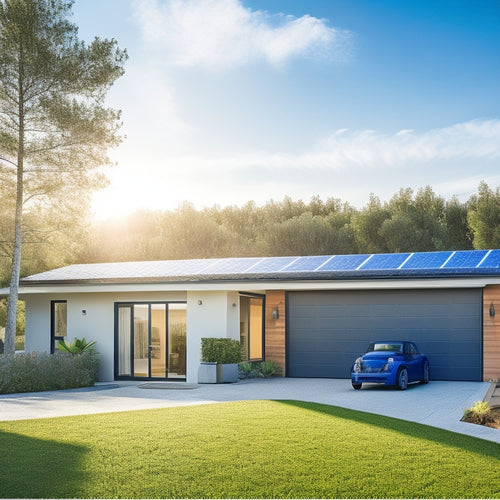
Key Steps for a Successful Residential Solar Installation
Share
You'll need to assess your property's solar potential, choosing the right installer, and selecting the ideal system for your energy needs. Make sure you evaluate your roof's condition, inspect local building codes, and review permits required for installation. You'll also want to maneuver through the permit process, optimize system performance, and maintain your solar investment through regular monitoring and upkeep. By following these key steps, you'll be well on your way to a successful residential solar installation. Now, let's explore deeper into each of these critical stages to guarantee you get the most out of your solar investment.
Key Takeaways
- Assess your property's solar potential through site evaluation, energy audit, and roof inspection to ensure optimal panel placement.
- Choose a qualified installer with licenses, certifications, and experience, and evaluate their communication and responsiveness.
- Select the ideal system type and size based on your energy needs, available space, and local codes, considering equipment quality and warranty.
- Navigate permits and inspections by securing necessary approvals, verifying compliance, and scheduling inspections with local authorities.
- Optimize system performance through regular monitoring, maintenance, and addressing potential issues early to maximize energy output and reduce repair costs.
Assessing Your Solar Readiness
Determine your solar potential by evaluating your property's solar-readiness. This involves an extensive site evaluation to assess the feasibility of installing a residential solar system.
You'll want to examine your property's orientation, shading, and roof size to determine the ideal placement and sizing of your solar panels.
Conduct an energy audit to identify areas of energy inefficiency in your home. This will help you understand your energy consumption patterns and pinpoint opportunities to reduce your energy usage.
A thorough energy audit typically includes an inspection of your home's insulation, windows, and HVAC systems.
Next, assess your roof's condition and structural integrity to guarantee it can support the weight of the solar panels.
You'll also need to evaluate any local building codes, permits, and regulations that may impact your solar installation.
Choosing the Right Installer
Trust plays an essential role in the success of your residential solar installation, as it hinges on the knowledge and reliability of the installer you choose.
You need an expert who can design and install a system that meets your energy needs and complies with local building codes. With so many installers out there, how do you make the right choice?
When researching potential installers, look for:
-
Installer qualifications: Confirm they've the necessary licenses, certifications, and experience in residential solar installations.
-
Installer reviews: Check online reviews from credible sources like Yelp, Google, and the Better Business Bureau to get a sense of their reputation and customer satisfaction.
-
Industry affiliations: Membership in industry associations, such as the Solar Energy Industries Association (SEIA), indicates a commitment to staying up-to-date with industry developments and best practices.
Selecting the Ideal System
With your energy needs and budget in mind, you're ready to select the ideal solar system for your home. You'll need to take into account the system types that best fit your requirements. The most common types are grid-tied, off-grid, and hybrid systems.
Grid-tied systems are the most popular, as they allow you to sell excess energy back to the grid. Off-grid systems are ideal for homes without access to the grid, while hybrid systems combine grid-tied and off-grid capabilities.
When evaluating system types, think about your energy needs and how much energy you want to generate. Assess your energy usage patterns to determine the required system size. You may want to take into account a system that covers 100% of your energy needs or one that supplements your energy usage.
Additionally, think about the space available for the system, local building codes, and any specific requirements from your utility company.
Lastly, take into account the equipment quality, warranty, and durability. Look for high-efficiency panels and inverters that meet your energy needs and budget.
Navigating Permits and Inspections
Steering Permits and Inspections
Secure the necessary permits and approvals before commencing the installation process to avoid costly delays and potential fines. You'll need to submit a permit application to your local government, which will vary depending on your location.
Confirm you have all required documents, including system design plans, electrical schematics, and manufacturer specifications.
Some key items to keep in mind during this process:
- Verify that your installation meets local building codes and regulations
- Schedule inspections with your local building department to guarantee compliance
- Create an inspection checklist to track progress and identify potential issues
Optimizing System Performance
Once you've secured the necessary permits and approvals, you can focus on optimizing your residential solar installation's system performance. This involves guaranteeing your system is running at maximum energy efficiency to generate the most power possible. To achieve this, it's essential to monitor your system's performance regularly. You can do this by tracking key performance indicators (KPIs) such as energy output, temperature, and voltage.
| Parameter | Target Range | Action |
|---|---|---|
| Energy Output | 80-90% of rated capacity | Check for shading, cleanliness, and panel damage |
| Temperature | 25-35°C | Confirm proper ventilation and cooling |
| Voltage | 240-250V | Check for loose connections and wiring issues |
Maintaining Your Solar Investment
Maintaining Your Solar Investment
Kick-start your long-term solar savings by taking proactive steps to maintain your residential solar installation. Regular maintenance is essential to guarantee your system operates at peak levels, maximizing your energy savings and extending its lifespan.
By staying on top of maintenance, you can also identify and address potential issues before they become major problems, reducing the need for costly repairs.
To get the most out of your solar investment, consider the following:
-
Monitor your system's performance regularly using advanced monitoring systems, which can detect even slight deviations from peak performance, allowing you to take prompt action.
-
Take advantage of financial incentives offered by government agencies and utility companies for maintaining and upgrading your solar installation.
-
Establish a maintenance schedule to guarantee that your system receives regular cleaning, inspection, and maintenance, ensuring it continues to generate clean energy at peak performance.
Frequently Asked Questions
Can I Install Solar Panels on a Metal or Clay Tile Roof?
You can install solar panels on a metal roof, but consider the roof's material, gauge, and fastening system to guarantee secure attachment. For clay tile roofs, you'll need specialized mounts and careful planning to maintain tile integrity and waterproofing.
Will Solar Panels Affect My Home's Resale Value?
You'll be pleased to know that installing solar panels can enhance your home's resale value, thanks to solar incentives and significant energy savings, making your property more attractive to potential buyers who value eco-friendliness and cost-effectiveness.
Can I Add More Solar Panels to My System Later?
"Don't put all your eggs in one basket" - you can expand your solar panel system later. You'll want to take into account installation factors, like available roof space and electrical infrastructure, to guarantee a seamless solar panel expansion that meets your growing energy needs.
Are There Any Solar Panel Warranties Available?
You'll find various solar panel warranties, typically 25 years or more, covering performance, materials, and workmanship, depending on the solar panel types, with some manufacturers offering extended warranty coverage for an additional fee.
Can I Use Solar Panels to Charge My Electric Vehicle?
As you drive into the sunrise, your electric vehicle's battery sips from the solar-powered fountain, fueling your daily commute. Yes, you can use solar panels to charge your EV, releasing EV benefits like reduced emissions and lower operating costs through solar charging.
Conclusion
You've done your due diligence, and your residential solar installation is up and running. Now, it's time to reap the benefits of your hard work. Remember, a successful solar installation is like baking a cake - you need to have all the right ingredients and follow the recipe to the letter. By following these key steps, you've guaranteed a sweet return on your investment, and your solar panels will be the icing on the cake for years to come.
Related Posts
-

Energy-Efficient Lighting Solutions for Sustainable Buildings
For sustainable buildings, energy-efficient lighting solutions, like LEDs, offer multiple benefits. These bulbs last ...
-

Solar Energy Storage Options for Homes
When considering solar energy storage options for your home, you'll find several effective solutions. Battery systems...
-

Integrating Smart Technology for Energy Savings
Integrating smart technology into your home is a transformative factor for energy savings. Smart thermostats give you...


